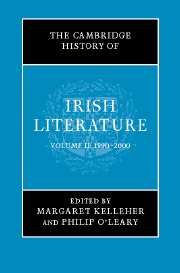Book contents
- Frontmatter
- Introduction
- 1 Literature and politics
- 2 The Irish Renaissance, 1890–1940: poetry in English
- 3 The Irish Renaissance, 1890–1940: prose in English
- 4 The Irish Renaissance, 1890–1940: drama in English
- 5 The Irish Renaissance, 1880–1940: literature in Irish
- 6 Contemporary prose and drama in Irish 1940–2000
- 7 Contemporary poetry in Irish: 1940–2000
- 8 Contemporary poetry in English: 1940–2000
- 9 Contemporary prose in English: 1940–2000
- 10 Contemporary drama in English: 1940–2000
- 11 Cinema and Irish literature
- 12 Literary historiography, 1890–2000
- Afterword: Irish-language literature in the new millennium
- Afterword: Irish literature in English in the new millennium
- Guide to major subject areas
- Index
- References
11 - Cinema and Irish literature
Published online by Cambridge University Press: 28 March 2008
- Frontmatter
- Introduction
- 1 Literature and politics
- 2 The Irish Renaissance, 1890–1940: poetry in English
- 3 The Irish Renaissance, 1890–1940: prose in English
- 4 The Irish Renaissance, 1890–1940: drama in English
- 5 The Irish Renaissance, 1880–1940: literature in Irish
- 6 Contemporary prose and drama in Irish 1940–2000
- 7 Contemporary poetry in Irish: 1940–2000
- 8 Contemporary poetry in English: 1940–2000
- 9 Contemporary prose in English: 1940–2000
- 10 Contemporary drama in English: 1940–2000
- 11 Cinema and Irish literature
- 12 Literary historiography, 1890–2000
- Afterword: Irish-language literature in the new millennium
- Afterword: Irish literature in English in the new millennium
- Guide to major subject areas
- Index
- References
Summary
So extensive has been the range of adaptations of Irish literary works for the screen that it is difficult to find a version of a major play or book that has not been seen in the cinema (or on television, an area largely outside of this discussion). Unsurprisingly, those works with a narrative thrust, which allow them to transcend their stage-bound or literary origins, have been favoured.
For our purposes, the range of adaptations discussed is confined to Irish-subject plays and novels (and short stories).Thus, Oscar Wilde does not feature, even though many of his most famous plays, such as Lady Windermere’s Fan (including a version directed by Ernest Lubitsch in 1925), and novel The Picture of Dorian Gray, have been adapted for screen. Indeed, two film versions of his notorious Salomé were produced in 1908 alone, while three adaptations of Dorian Gray were made before 1915. Similarly, Bernard Shaw is omitted even though many of his plays were filmed, including his Arms and the Man, which was made into The Chocolate Soldier in 1914, and Pygmalion, which won an Oscar in 1938 (there were also German and Dutch filmed versions in the 1930s); but his key ‘Irish’ play, John Bull’s Other Island (1904), has yet to be made into a feature film. While all Samuel Beckett’s stage works have been adapted for the (small) screen, as has his one ‘screenplay’, Film, made as a 22-minute cinema film in 1964, and featuring Buster Keaton, these are not discussed here. Other omissions reflect the course of cinematic history.
- Type
- Chapter
- Information
- The Cambridge History of Irish Literature , pp. 531 - 561Publisher: Cambridge University PressPrint publication year: 2006
References
- 2
- Cited by

